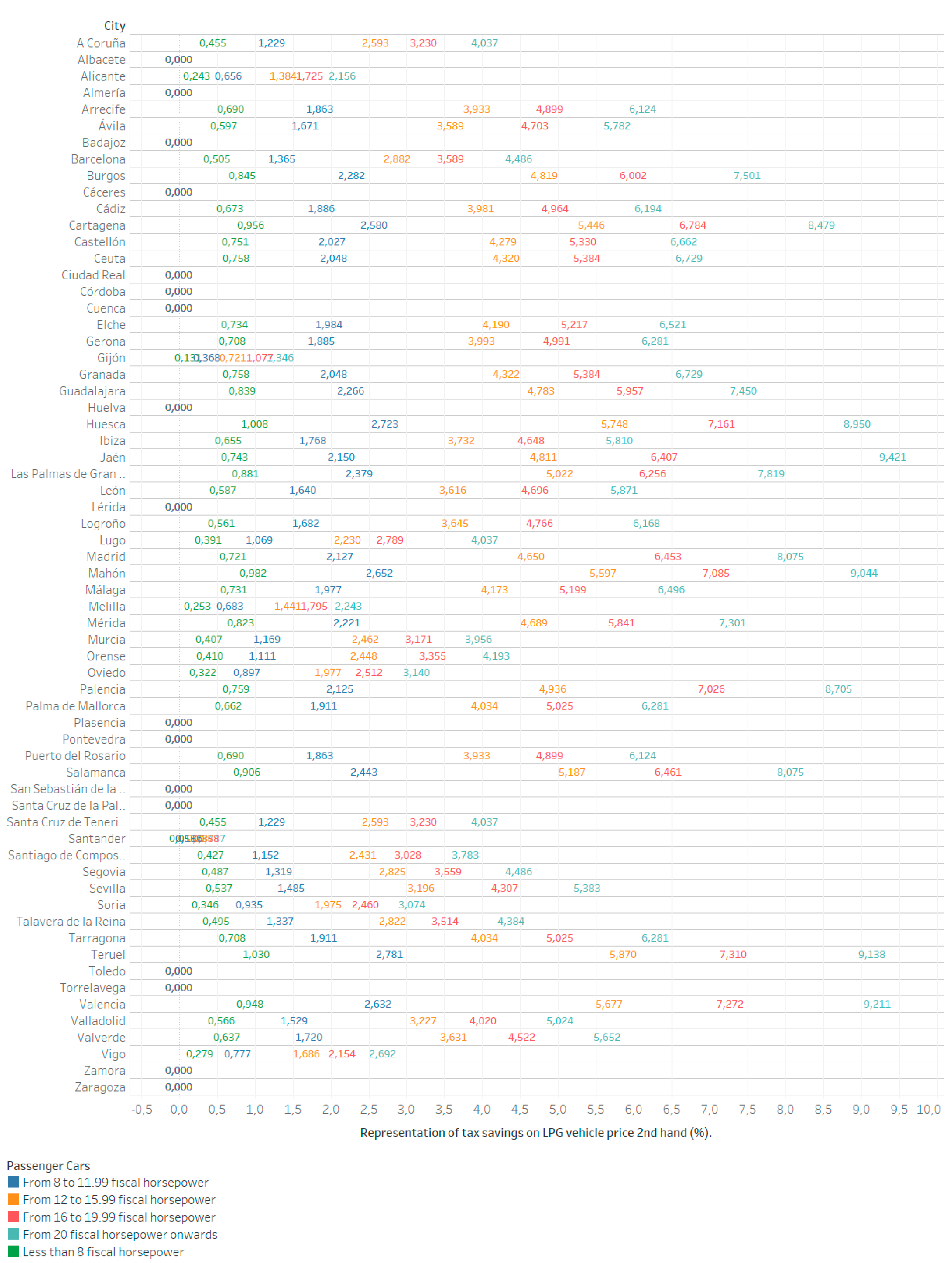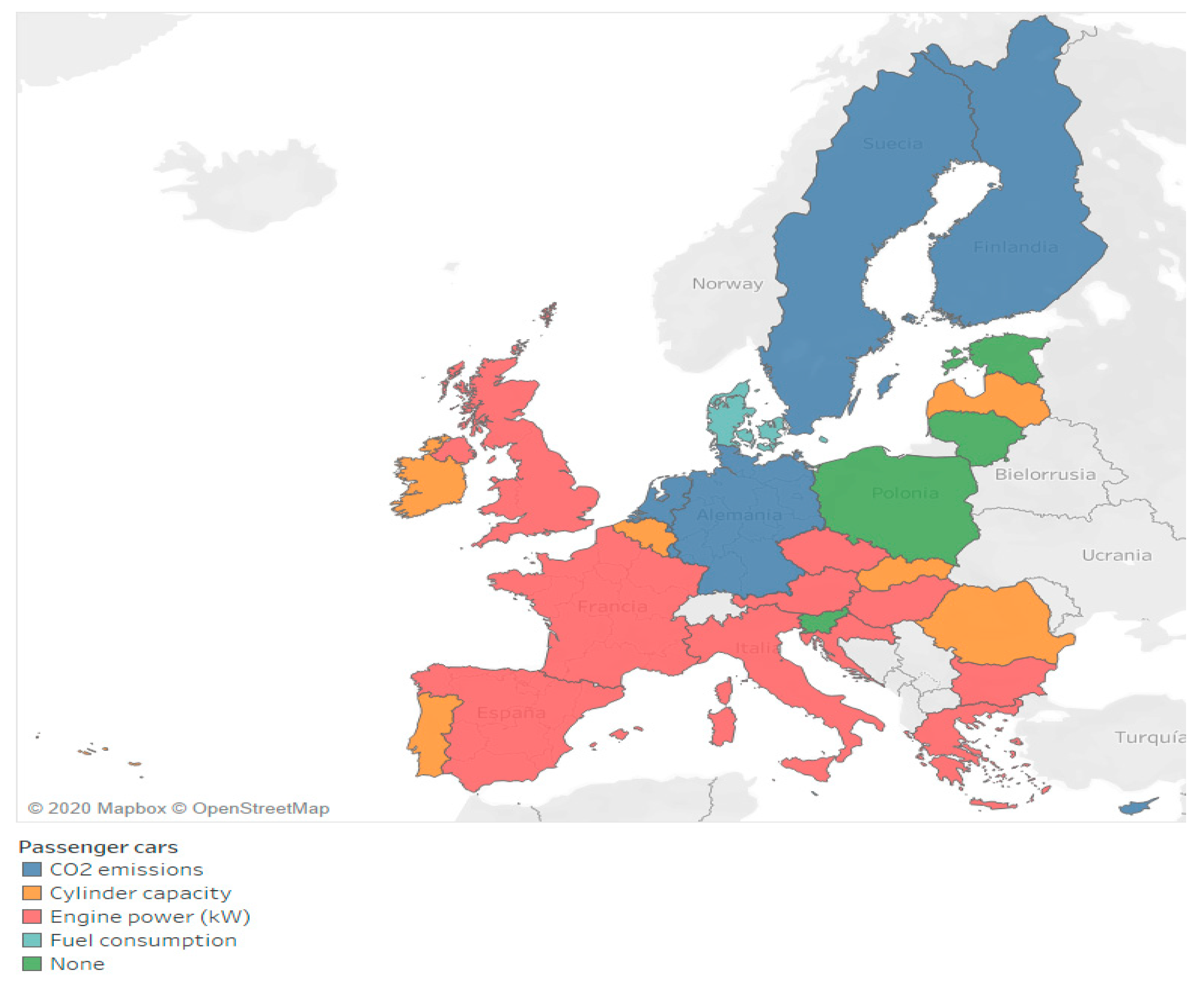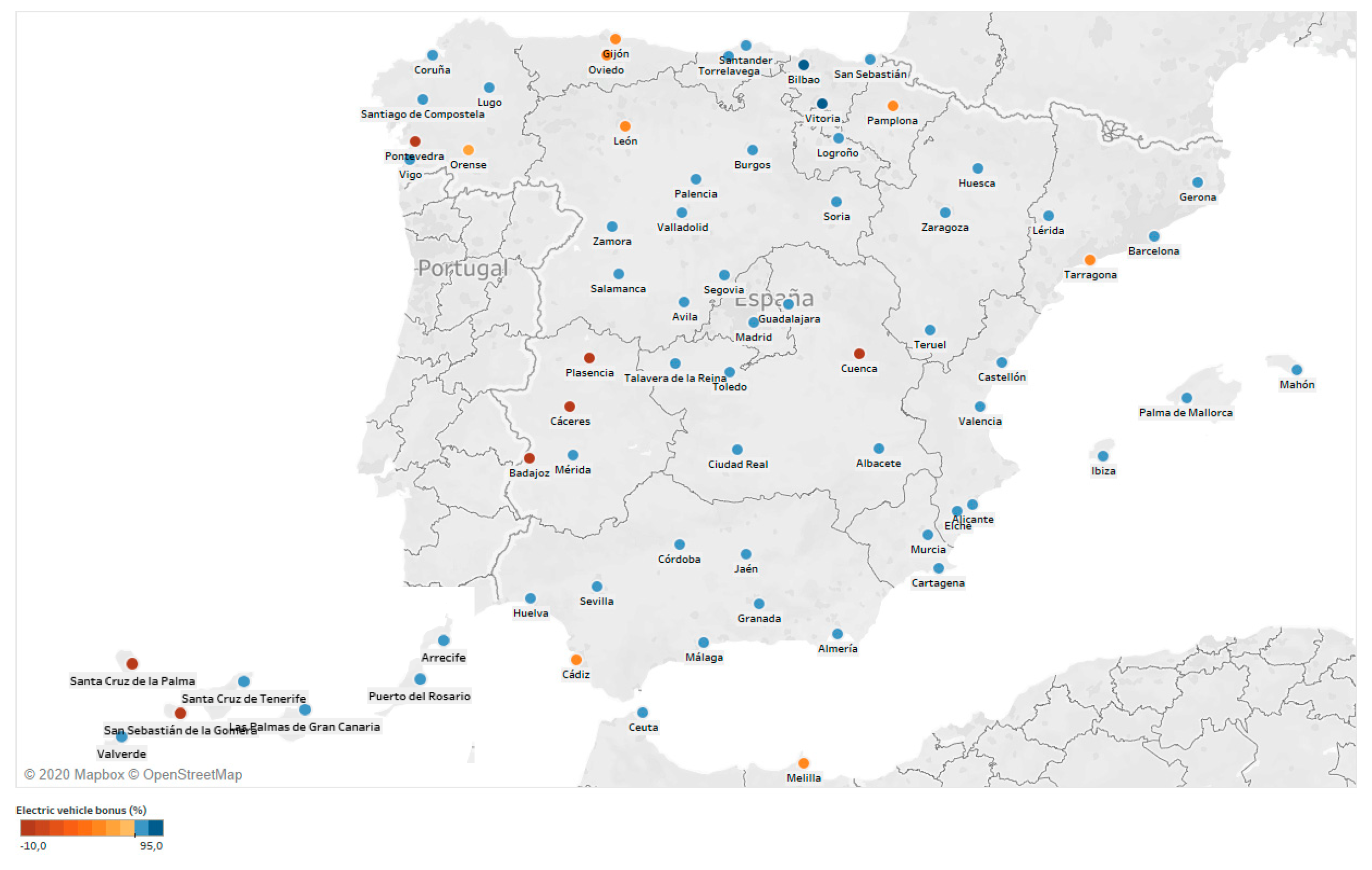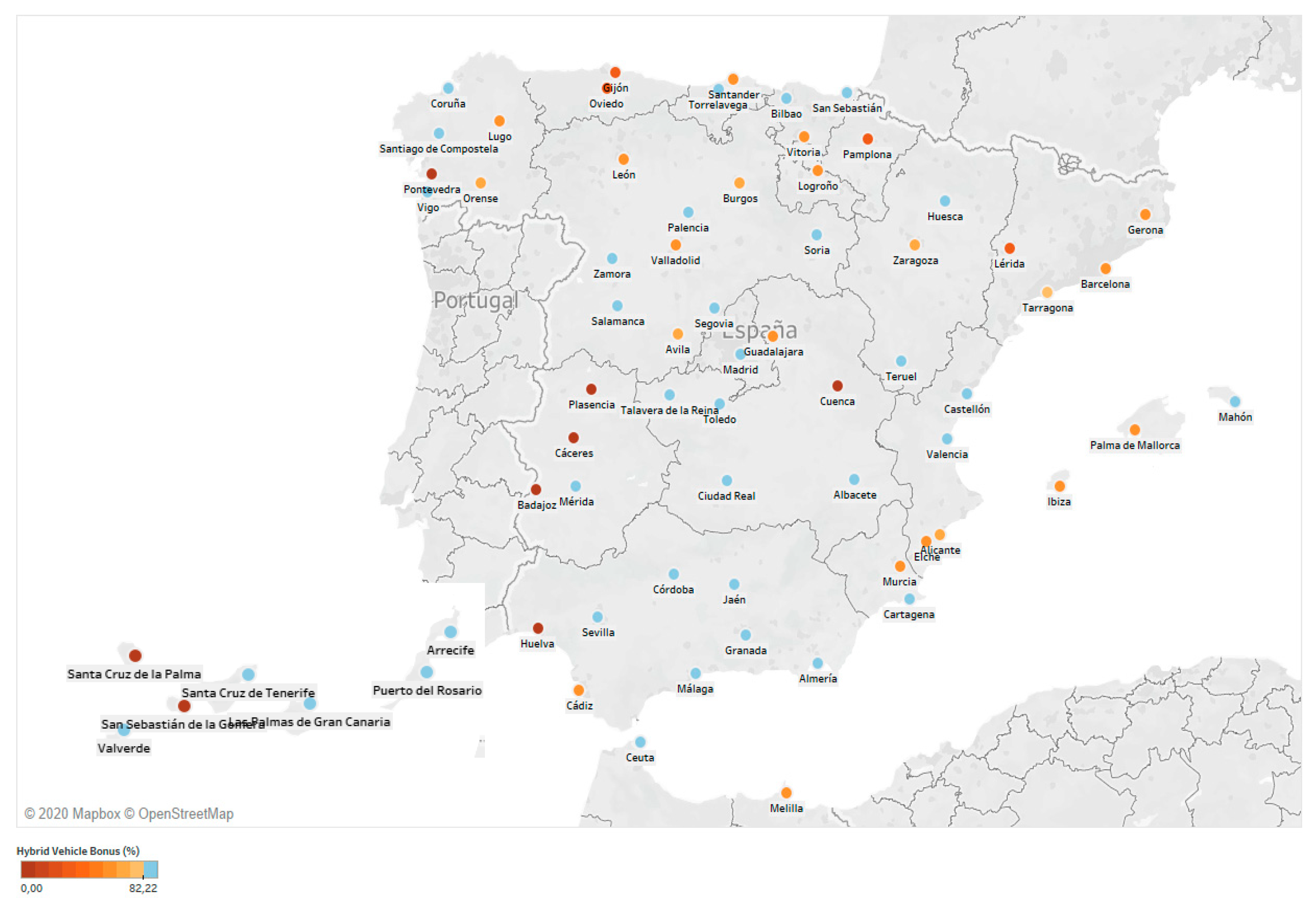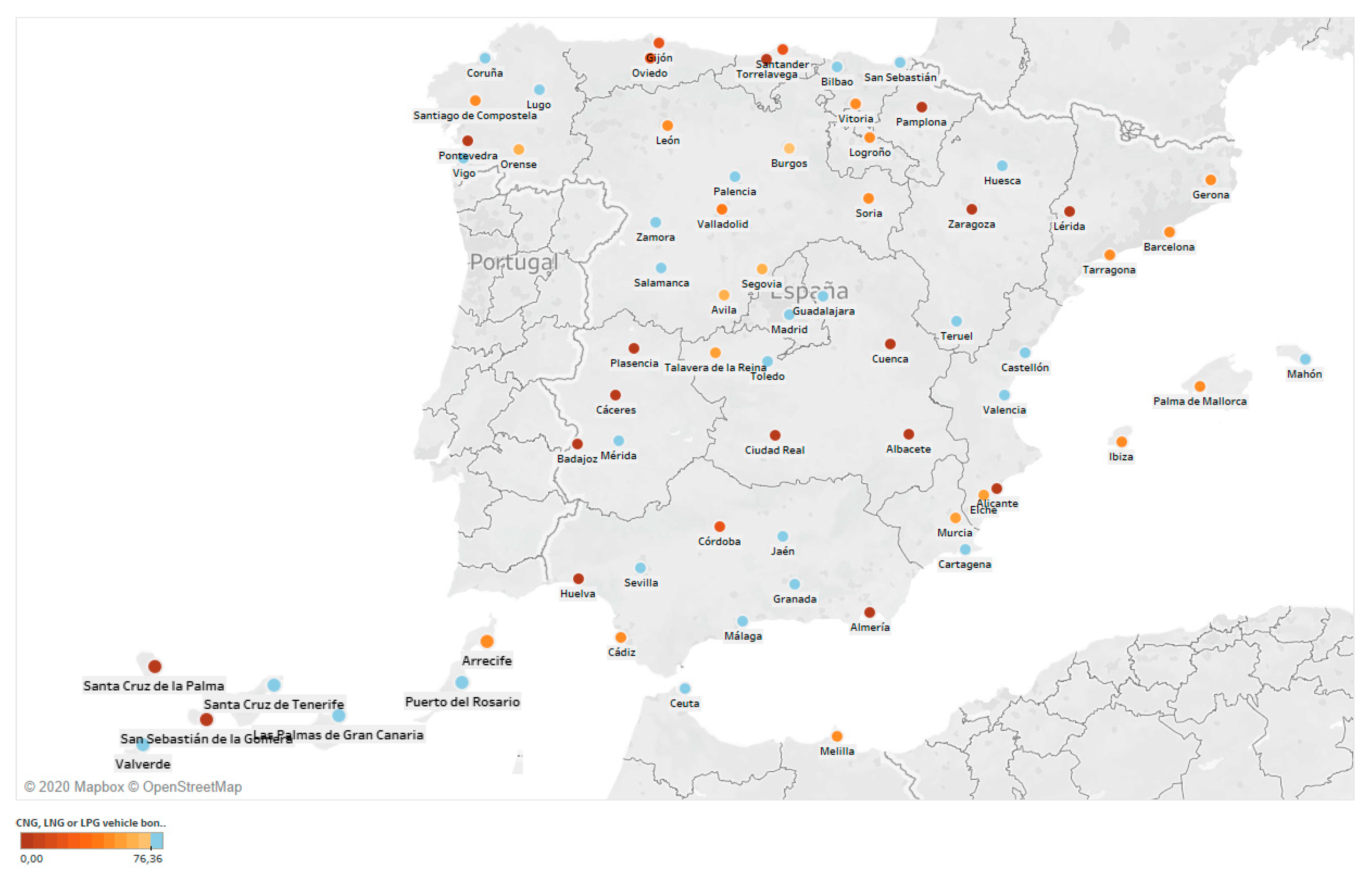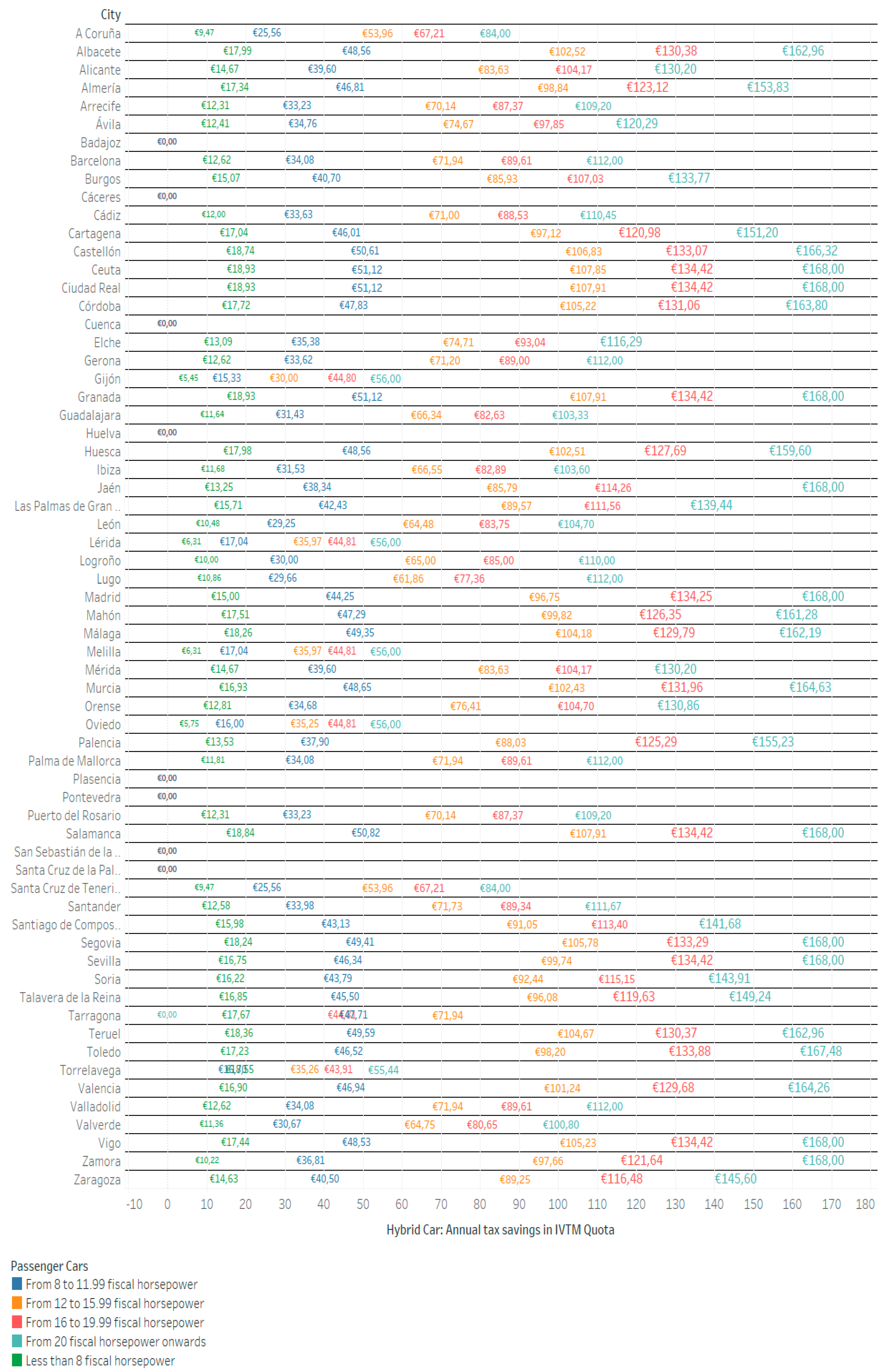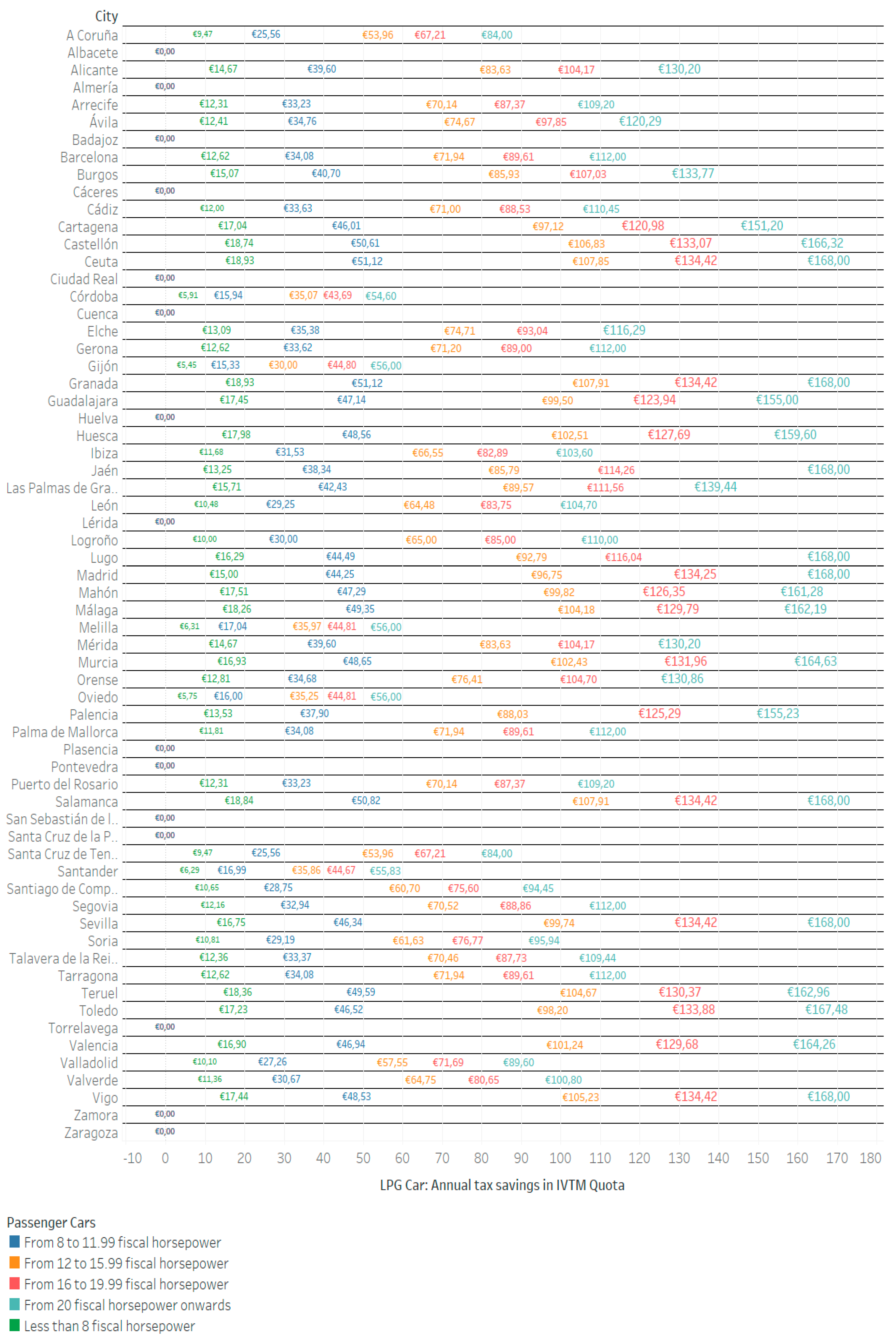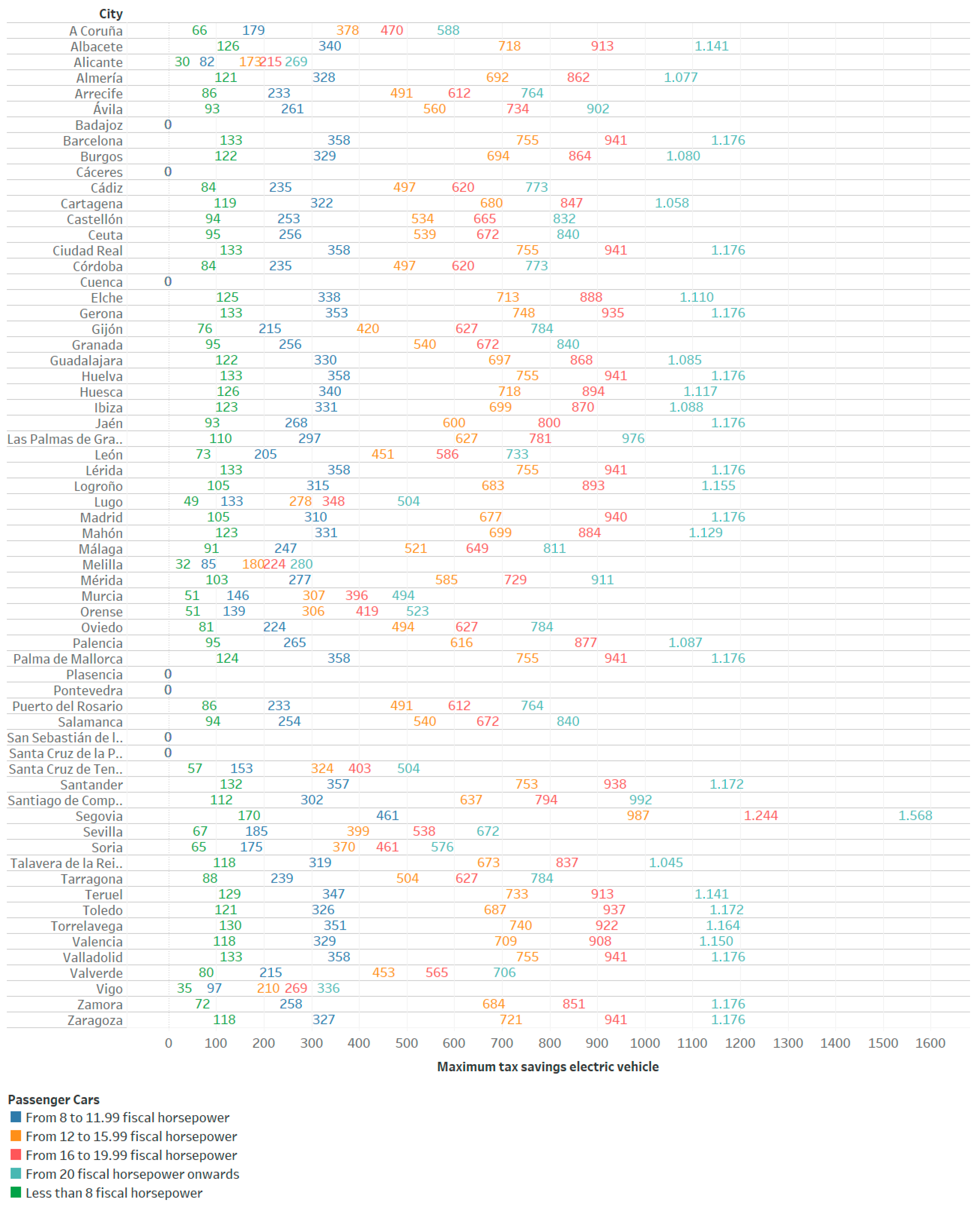1. Introduction
On January 21, 2020, the Spanish government declared a “climate emergency” in order to respond to the demands of the scientific community, which calls for “urgent action to safeguard the environment, health and safety of citizens.” [
1] Among the objectives proposed by the government in the activation of the climatic a passenger fleet of commercial vehicles passenger car park and commercial vehicles with emissions of 0 grams of CO
2 per kilometre […] and a fiscal, budgetary and financial system compatible with the necessary decarbonisation of the economy and society.” Added to this is the establishment of “low emission areas” [
2] in Spanish cities with more than 50,000 inhabitants. In line with the above, some Spanish cities such as Madrid and Barcelona have already established “zero emission” zones, where only low-pollution vehicles such as electric vehicles, hybrids, and, in some cases, vehicles powered by liquefied petroleum gas (LPG) [
3,
4] can circulate.
Due to the above regulations, the electric car not only will play a very important role in the future but also does so in the present. The promotion of the electric vehicle will bring with it some difficulties such as the “acceptance of use by users with less autonomy and speed or longer duration in recharging, among others.” [
5] Other possible problems with acceptance [
6] also include the initial price of the vehicle and the possible difficulty in finding charging points for the vehicle. However, [
6] also indicates that there are advantages such as access to the zero-emission zones and the low pollution that the vehicles generate, which is also indicated by [
7], adding “parking facilities in the city.” Both [
5] and [
6] indicate that other possible advantages of the electric vehicle would be, on the one hand, the possible access to subsidies and, on the other hand, tax incentives. This article analyzes the tax incentives associated with the electric vehicle, granted through the tax on mechanical traction vehicles (hereinafter IVTM), because as indicated in [
8], “At present, incentive policies are needed to help its implementation,” that is, incentives for the acceptance and use of the electric vehicle.
Despite the environmental benefits that the “eco-friendly car” can bring, there are nevertheless voices that do not see electric vehicles in the same way. This has to do with the contamination derived from the use of electric batteries by these vehicles, and with the notion that a greater number of electric vehicles will lead to an increase in the demand for energy. The question here is whether that energy will be produced using environmentally friendly sources (solar or wind energy, for example). The importance of tax incentives for low-pollution vehicles has been analyzed, along with the regulations applicable in Spain and the operation of the IVTM. Additionally, an analysis has been carried out on how the tax incentives affect the adoption of an eco-friendly car and how they were developed. The objective is to verify the differences between cities, both quantitatively and qualitatively.
Based on what was previously described, three issues have been raised, which are the object of study of this article:
- -
Are there significant differences in the fiscal policy of encouraging the ownership of “eco-friendly cars” in Spain?
- -
Are Spanish citizens being sufficiently incentivized via tax incentives to own “eco-friendly cars”?
- -
Should the tax incentive applicable to the ownership of “eco-friendly cars“ be supplemented by other measures?
Despite the positive tax incentives of the IVTM in favor of low-polluting vehicles, the regulations act as limits preventing city councils from even encouraging these types of vehicles. On the other hand, this tax is not the only decisive element when it comes to encouraging the acquisition of low-polluting vehicles; it must be complemented by other incentives via subsidy or other types of policy. The tax incentive, as I have analyzed in this article, has a reduced impact; and the incentive included in the “moves” plan has limits that reduce its effectiveness. Despite the environmental benefits that the “eco friendly car” can bring, there are, however, voices that do not see electric vehicles in the same positive way. The research is structured as follows.
The article presents a review of the literature, followed by a legal analysis of the tax. Subsequently, a qualitative and quantitative analysis is carried out in
Section 3 and
Section 4, respectively. In
Section 5, a calculation of the tax savings caused by the incentives in the IVTM fee for owners of "eco-friendly cars" is performed; and in
Section 6, a calculation of total tax savings on the IVTM fee and on the price of a new or secondhand vehicle is performed. In
Section 7, a comparison is made between the tax incentive collected in the IVTM and the incentive to purchase an “eco-friendly car” established in the “moves” plan. Finally,
Section 8 presents the discussion and conclusions.
2. Literature Review
Some comparative studies at the international level, such as the one carried out in [
9], point out that among the main factors to consider in encouraging greater use of the electric vehicle is “the need for incentives for its expansion, especially via subsidies,” a position that is reinforced in [
10] when the author emphasizes the need for “favourable public subsidies” for the electric car. However, we must also consider the position of [
11] when the authors indicate that “more subsidies do not always involve more sales” or greater acceptance, purchase, and use of the electric vehicle. This last position is also shared in [
12] and [
13], studies on reducing incentives for the purchase of electric vehicles in the European Union. At a more local level, studies have also been carried out on the effect of incentives via electric vehicle subsidies in Norway and the Netherlands, where different scenarios for the subsidization of electric vehicles and their effects were analyzed [
14]; in Denmark, along with the incentives for its purchase [
15], some psychological factors were also added.
Another way to achieve greater acceptance of the electric vehicle among citizens may be the use of favorable tax policy or tax incentives. As early as the year 2011, it was noted in [
16] that the most influential factor for US citizens in adopting an electric vehicle quickly was tax incentives, because in the study, the author concluded that these tax incentives were the factor that most affected consumers in their final decisions. In South Korea, a study [
17] was conducted based on a sample of 250 householders, and the importance of tax incentives when purchasing an electric vehicle was shown. In 2014, at the local level [
18], research was conducted in the city of Stockholm, and it was concluded that “the tax had a significant effect on ethanol car purchases”; in other words, taxation and the presence or absence of tax incentives significantly affected the acquisition of low-pollution vehicles. The same conclusion was obtained in 2015 [
19] in a study in the Netherlands, which found that “tax incentives directly affect the purchase of electric vehicles” and that “car tax incentives are the main driver for lower CO
2-emitting passenger cars.”
In 2016, a study carried out in Norway [
20] and another one conducted in Europe [
21] once again found that one of the most important factors in increasing the purchase of electric vehicles by families and drivers is the tax incentives that the government or the authorities establish in favor of the electric or less-polluting vehicle. In 2019, the study presented in [
22], carried out in the Netherlands, concluded that “tax incentives for specific vehicle types can be a powerful policy instrument.” This same position was also maintained by the authors of [
23] in research conducted on incentives for the electric vehicle, in this case in Colombia. At a higher level of analysis than the previous two studies, the authors of [
24] came to the same conclusion: “tax incentives cause a rapid penetration of the electric vehicle” in five European countries (Germany, Austria, Spain, the Netherlands, and the United Kingdom).
It should be noted that some authors have criticized environmentally friendly vehicles, since they are not as respectful to the environment as is generally thought. According to [
25], environmentally friendly cars “pollute between 11% and 28% more than diesel ones.” This is mainly due to the batteries of these cars, made from lithium, cobalt, and manganese, and to the process of their production, which entails high energy consumption. The authors further pointed out that “it is a deception that European policy classified electric cars as zero emission vehicles.” In relation to this last statement, there would be an increase in the production of electrical energy in Europe; according to [
26], the “road transport sector [will drive] an additional electricity demand of 1200 TWh in EU in 2050,” also ensuring that “the costs of production and replacement (of the fuel by electricity) have been wrongly calculated.”
Given the importance that tax incentives have in the promotion of the electric vehicle, this article presents a study on the tax incentives in Spain that make it beneficial to purchase electric vehicles. More specifically, this study focuses on a specific tax, the mechanical traction vehicle tax (IVTM).
3. The Tax on Mechanical Traction Vehicles: Applicable Regulations and Comparisons with Other EU Countries
The IVTM is a tax on the ownership of vehicles of mechanical traction that travel on public roads, and according to the norm, it is a direct tax, established in Spain, of municipal ownership that is obligatory and whose management corresponds entirely to the city councils [
27]. It is a tax on the ownership of mechanical traction vehicles suitable for driving on public roads, regardless of their class and category. Vehicles that have been registered in the corresponding public records are considered fit for circulation, as long as they do not cause casualties [
28]; the taxpayers are the natural or legal persons, or entities without personality, in whose name the vehicle appears on the traffic permit.
Thus, the regulation itself specifies a series of exemptions, among which the electric vehicle does not appear, but there is a series of possible bonus reductions in the fee. The electric vehicle in Spain can benefit from a bonus reduction, and this is what we focus on. First, we must explain how the calculation of the quota works. The regulations establish that “the tax will be required according to the following table of annual rates” [
29] (see
Table 1). As we can see, therefore, in
Table 1, the power of the vehicle’s engine is transformed into fiscal horsepower when calculating the tax payment. However, this quota will not be the same throughout Spanish territory.
The reason is that the regulations themselves establish that municipalities may increase the quotas set (see
Table 1) “by applying a coefficient on them, which may not exceed 2 (double).” In turn, the regulations themselves indicate that the municipalities “may set a coefficient […] that may, in turn, be different for each of the sections set in each class of vehicle, without exceeding in any case the maximum limit set” (coefficient of 2 or double) [
30]. If the municipalities have not established their own coefficient, the quotas contained in
Table 1 apply to the vehicle.
Regarding exemptions, the regulations do not allow municipalities to exempt electric vehicles from taxation under any circumstances. However, they do enable municipalities to subsidize low-pollution vehicles as follows [
30]:
- -
“A bonus of up to 75% depending on the type of fuel consumed by the vehicle, due to the incidence of combustion of said fuel in the environment.”
- -
“A bonus of up to 75% depending on the characteristics of the engines of the vehicles and their impact on the environment.”
This previous regulation affects all Spanish autonomous communities that are governed by it, the exceptions being Basque Country and Navarre which have their own regulatory provisions.
It is relevant to note that this tax is paid in Spain only once a year. The exception would be those municipalities that allow the payment to be divided into two instalments; but in the end, the final amount to be paid will be the same.
In the other countries of the European Union, there are also taxes similar to those in Spain that we have analyzed. These taxes, according to [
31] and [
32], tax the possession of a passenger vehicle based on various aspects. All of this can be seen comparatively in
Figure 1 below.
In the cases of Austria, Bulgaria, Croatia, Czech Republic, France, Greece, Hungary, Italy, Spain, and the United Kingdom, the tax is paid based on engine power.
In another group of countries, among which we find Belgium, Ireland, Latvia, Portugal, Romania, and Slovakia, the tax is paid based on the cylinder capacity. In another large group of European countries, the tax is paid based on CO2 emissions, we include Cyprus, Finland, Germany, Luxembourg, Malta, the Netherlands, and Sweden. In the case of Denmark, the tax is paid based on fuel consumption.
Finally, there is a group of countries that do not file taxes on ownership, which are Estonia, Lithuania, Poland, and Slovenia.
4. Qualitative and Quantitative Analysis of the Tax Incentives in the IVTM in Favor of “Eco-Friendly Cars”
In the previous sections, the importance of tax incentives for low-pollution vehicles was analyzed, as well as the regulations applicable in Spain and the operation of the IVTM.
In this section, an analysis is carried out on how the tax incentives affect the adoption of an eco-friendly car and how they were developed.
The objective is to verify the differences between cities, both quantitatively and qualitatively. In a later section, a calculation is made of the tax savings caused by the incentives for owners of low-pollution vehicles (electric, hybrid, or LPG).
In the sample, the current tax regulations in 68 Spanish cities were analyzed. This includes all provincial capitals, with the addition of some of the most populous cities that are not provincial capitals and islands.
As we anticipated, none of the 68 Spanish cities examined had established a tax exemption in the IVTM in favor of “low pollution” vehicles. Even if the city council of one of those cities tried to do so via tax ordinance, it could not.
The reason is that the municipalities do not have the competence to do so, since it is the government that should do so via modification of the legal text that regulates the IVTM.
Therefore, a very important limit is observed in order to subsidize and encourage the use of the low-pollution vehicle. This is collected in
Table A1, which is inserted in
Appendix A.
Regarding the bonus reduction in the IVTM fee for electric, hybrid, or LPG vehicles, only 7 of the 68 cities analyzed do not contain any bonus reductions. This represents 10.2% of the total analyzed; conversely, 61 cities of the 68 analyzed (89.7%) have at least one tax bonus in favor of the low-pollution vehicle.
The bonus reduction in the fee for the electric vehicle ranges from 50% to 75%. (Cities in the Basque Country and Navarra regions, given that these regions have their own regulations, may have different limits.) Of the cities surveyed, 83.6% (51 in absolute numbers) have a 75% bonus reduction in the tax quota. One city, Orense, has a 60% bonus reduction (1.64% of those studied), and 11.5% (seven in absolute numbers) have a 50% bonus reduction in their tax quotas. As we indicated, six cities did not present any bonus reduction (10.2%). It should be noted here that two cities in the Basque Country have a bonus reduction of more than 75% in the share of taxes in favor of the electric vehicle: Bilbao, with a 95% bonus reduction, and Vitoria, with a 90% bonus reduction.
Regarding the temporal duration of the applicable bonus reduction in the IVTM fee for the electric vehicle, the range is between two years (see Vigo in
Figure 2) and an indefinite duration “while maintaining the circumstance that gave rise to the bonus.” The indication “as long as the circumstance that gave rise to the bonus is maintained” assumes that the tax rate bonus will remain without an expiration date, provided that the holder and the vehicle are still registered.
Of the 61 cities that contain a bonus reduction in favor of the electric vehicle, 44 cities established an indefinite bonus reduction duration (about 72.1%), the city of Segovia has a duration of seven years (1.64% of the total), Santa Cruz de Tenerife and Vitoria have a duration of six years (3.3% of the total), and 6 cities have a duration of five years (9.9% of the total). Bonus reduction durations below five years are present in three cities with four years (4.97%), in four cities with three years (6.56% of the total), and with two years only in the city of Vigo (1.64% of the total).
The bonus reduction for the hybrid vehicle ranges in this case between 25% and 75%. It is noteworthy that the deduction limit for the hybrid vehicle is lower than that for the electric vehicle. Again, 8 of the 68 cities analyzed do not contain a bonus reduction in favor of the hybrid vehicle (12.88% of the total). Of the cities in the sample, 58.1% (35 in absolute terms) have a 75% bonus reduction in the IVTM fee in favor of hybrid vehicles. As we can see, it is a lower figure than that for the electric car. One city (Tarragona) has a 70% bonus reduction (1.66% of the total). A bonus reduction of 65% in the fee is only observed in two cities (Burgos and Zaragoza), which represents 3.22% of the total. We found a 60% bonus reduction in the tax shares in three cities (4.98% of the total). Another 13 cities (21.58% of the total) contain a 50% bonus in the IVTM fee in favor of the hybrid vehicle, and, finally, 4 cities (6.64% of the total) have a 25% bonus reduction in the fee. (In the case of the city of Tarragona (Catalonia), there is a progressive scale for hybrid vehicles. In this way, the bonus is greater (75%) for vehicles with less fiscal horsepower than those with more fiscal horsepower (0%). In the case of Alicante (Valencian Community), the bonus is progressive but based on time. In this way, the first year is 75%, the second 50%, and the third 30%.)
Of the 60 cities that contain a bonus reduction in favor of the hybrid vehicle, 27 cities established an indefinite bonus duration (44.82% of the total), the city of Segovia has a duration of seven years (1.66% of the total), 5 cities have a duration of six years (8.5% of the total), and 11 cities have a duration of five years (18.26% of the total). Bonus durations below five years are present in seven cities with four years (11.62% of the total), in five cities with three years (8.5% of the total), with two years only in the city of Vigo (1.66% of the total), and with one year only in the city of Lleida (1.66% of the total).
The bonus reduction in the tax fee for the LPG-CNG vehicle, etc., again ranges between 25% and 75%. The lower deduction limit for the LPG vehicle (as in the case of the hybrids) is smaller than in the case of the electric vehicle. In this case, 15 of the 68 cities analyzed do not contain a bonus reduction in favor of the LPG-CNG vehicle, etc. (22.05% of the total). Of the cities studied, 47% that have a bonus (25 in absolute terms) have a 75% bonus reduction in the IVTM fee in favor of LPG-CNG vehicles. As we can see, it is a lower figure than that for the electric car and hybrids. A bonus reduction of 65% in the fee is only observed in one city (Burgos), which represents 1.88% of the total. We found a 60% bonus reduction in the tax share in three cities (5.64% of the total) and 55% in three others (5.64% of the total). Another 13 cities (24.44% of the total) contain a 50% bonus reduction in the IVTM fee in favor of the hybrid vehicle. In Valladolid, we found a 40% bonus reduction in the quota (1.88% of the total cities), and, finally, three cities (5.64% of the total) have a 25% bonus reduction in the fee. Of the 53 cities that contain a bonus reduction in favor of the LPG-CNG vehicle, 23 cities established an indefinite bonus duration (43.24% of the total). We did not find in this case any city with a bonus period of seven years. Five cities have a duration of six years (9.4% of the total), and six cities have a bonus duration of five years (11.28% of the total). Bonus durations below five years are present in five cities with four years (9.4% of the total), in five cities with only three years (9.4% of the total), with two years only in the city of Vigo (1.66% of the total), and with one year only in the city of Santander (1.66% of the total). In this section, we can see how there are big differences among the three categories of low-polluting vehicles analyzed (electric, hybrid, and LPG) in terms of their tax treatment via bonus reductions in the IVTM. There are differences in terms of the percentage of bonus to be applied and with respect to the period in which the tax rate bonus is applicable. In
Figure 2,
Figure 3 and
Figure 4, these differences can be observed on a map of Spain.
5. Calculation of the Tax Savings Caused by the Incentives in the IVTM Fee for Owners of “Eco-Friendly Cars”
In this section, a calculation is made of the tax savings for acquiring an electric vehicle, hybrid, or vehicle powered by LPG-CNG.
Depending on the municipality, the fiscal horsepower of the vehicle and the proposed bonus, considering the time limit for this, the methodology followed for the calculation is defined in the following formulas: tax rate x% applicable bonus = tax savings.
Before continuing with the application of the proposed method, it is noted that the research does not consider the elasticity of supply or demand for electric vehicles over time.
In
Figure 5, we can observe the result of the application of Equation (1), from which we obtain the annual savings on the quota of the IVTM, depending on the municipality and the fiscal horsepower of the vehicle.
For the electric vehicle, we can see that the average bonus reduction in the 68 Spanish cities studied is €74.4 per year (with a 95% confidence interval, the ends of the confidence interval being €68.3 and €80.5), while the median is €70.1 per year (with a 95% confidence interval, the ends of the confidence interval being €45.2 and €90). In turn, the average bonus reduction for the upper quartile is €122.5, and that of the lower quartile is €18.3 per year.
In absolute terms, the maximum annual deduction is €168, while the minimum is €0 in those cities that do not contemplate any bonus.
In
Figure 6, we can observe the result of the application of Equation (1), from which we obtain the annual savings on the quota of the IVTM according to the municipality and the fiscal horsepower of the vehicle, in this case for the hybrid vehicle.
We can observe that the bonus reduction average in the 68 Spanish cities studied is €64.2 per year (with a confidence interval of 95%, the extremes of the confidence interval being €58.5 and €69.8), while the median is €50.7 per year (with a confidence interval of 95%, the extremes of the confidence interval being €39 and €62.4).
In turn, the average bonus reduction for the upper quartile is €105.2, and that of the lower quartile is €16.9 per year. In absolute terms, the maximum annual deduction is €168, while the minimum is €0 in those cities that do not contemplate any bonus.
In
Figure 7, we can observe the result of the application of Equation (1), from which we obtain the annual savings on the quota of the IVTM, depending on the municipality and the tax horsepower of the vehicle, in this case for the LPG-CNG vehicle.
It is evident that the average bonus reduction in the 68 Spanish cities studied is €54.2 per year (with a 95% confidence interval, the extremes of the confidence interval being €48.6 and €59.8), while the median is €41.6 per year (with a 95% confidence interval, the extremes of the confidence interval being €31.7 and €51.5).
The average bonus for the upper quartile is €96.1, and that of the lower quartile is €8.7 per year. In absolute terms, the maximum annual deduction is €168, while the minimum is €0 in those cities that do not contemplate any bonus.
6. Calculation of Total Tax Savings on the IVTM Fee and on the Price of a New or Secondhand Vehicle
In this section of the study, we start with the equation: total tax savings = sum bonus year 1, year 2, year 3 ... year n. Algebraically,
In this way, if we add the total tax savings on the quota of the IVTM in each city studied, depending on the type of vehicle (electric, hybrid, or LPG-CNG), and based on the years in which the bonus can be applied, we can extract the following:
The total tax savings or savings (defined in Equation (2));
The representation of the tax savings on the price of a new vehicle (electric, hybrid, or LPG) in %;
The representation of the tax savings on the price of a secondhand vehicle (electric, hybrid, or LPG) in %.
The average price of a new vehicle is extracted from the report of [
33], which places this figure for the year 2019 (the last year for which data are available and the year which is most current) at €17,588 per vehicle. Regarding the average price of a secondhand vehicle, it is extracted from the report of [
34], which places this figure at €12,483 per vehicle. Likewise, the data refer to the year 2019, the last year for which data are available and the year which is most current.
The tax savings have been calculated for a maximum period of seven years, even though some cities may contain an indefinite duration for the bonus reduction in the IVTM fee. Recall that there are cities in which the bonus period is shorter, and for those cases, the savings were calculated over four or three years, etc., as allowed by the regulations.
Taking as a reference that Spanish citizens with their own vehicle, according to [
35], drive an annual average of 24,000 km, a vehicle with seven years of usage (the maximum period for which the possible bonus deduction is calculated, despite having an indefinite duration) would have travelled an average of 168,000 km, close in many cases to the end of its useful life.
Before continuing with the application of the proposed method, it is noted that the research does not consider the elasticity of supply or demand for electric vehicles over time.
Hence, after analyzing the data in this section, we can show whether the tax savings on the IVTM quota could sufficiently incentivize a consumer to acquire a low-pollution vehicle. For this, we display three new figures and six other figures in
Appendix A.
From
Figure 8, we can extract the maximum average tax savings for an electric vehicle, which would be €467 (with a confidence interval of 95%, the extremes of the confidence interval being €426 and €508), while the median is €358 (with a confidence interval of 95%, the extremes of the confidence interval being €263 and €453).
In turn, the average bonus reduction for the upper quartile is €755, and for the lower quartile it is €123. In absolute terms, the maximum deduction is €1568, while the minimum is €0 in those cities that do not contemplate any bonus.
Regarding the tax savings on the price of a new electric vehicle (in %) (
Figure A1,
Appendix A), the average is 2.65% (with a confidence interval of 95%, the extremes of the confidence interval being 2.424% and 2.887%), and the median is 2.035% (with a confidence interval of 95%, the extremes of the confidence interval being 1.493% and 2.577%). The average bonus reduction for the upper quartile is 4.295%, and that of the lower quartile is 0.697%. Regarding the tax savings on the price of a secondhand electric vehicle (in %) (
Figure A2,
Appendix A), the average is 3.84% (with a confidence interval of 95%, the extremes of the confidence interval being 3.51% and 4.18%), and the median is 2.94% (with a confidence interval of 95%, the extremes of the confidence interval being 2.16% and 3.73%). In turn, the average bonus reduction for the upper quartile is 6.21%, and that of the lower quartile is 1.01%.
From
Figure 9, we can extract the maximum average tax savings for a hybrid vehicle, which would be €350 (with a confidence interval of 95%, the extremes of the confidence interval being € 206 and €375), while the median is €254 (with a confidence interval of 95%, the extremes of the confidence interval being €203 and €306). The average bonus reduction for the upper quartile is €569, and that of the lower quartile is €71. In absolute terms, the maximum deduction is €1176, while the minimum is €0 in those cities that do not contemplate any bonus. Regarding the tax savings on the new hybrid vehicle price (in %) (
Figure A3,
Appendix A), the average is 1.935% (with a confidence interval of 95%, the extremes of the confidence interval being 1.737% and 2.132%), and the median is 1.446% (with a confidence interval of 95%, the extremes of the confidence interval being 1.737% and 2.132%). In turn, the average bonus reduction for the upper quartile is 3.236%, and that of the lower quartile is 0.404%. Regarding the tax savings on the secondhand hybrid vehicle price (in %) (
Figure A4,
Appendix A), the average is 2.726% (with a confidence interval of 95%, the extremes of the confidence interval being 1.737% and 2.132%), and the median is 2.037% (with a confidence interval of 95%, the extremes of the confidence interval being 1.624% and 2.450%). The average bonus reduction for the upper quartile is 4.559%, and that of the lower quartile is 0.570%.
From
Figure 10, we can see that the maximum average tax saving for an LPG-CNG vehicle is €299 (with a confidence interval of 95%, the extremes of the confidence interval being €265 and €333), while the median is €209 (with a confidence interval of 95%, the extremes of the confidence interval being €265 and €333). The average bonus reduction for the upper quartile is €526, and for the lower quartile, it is €0. In absolute terms, the maximum deduction is €1176, while the minimum is €0 in those cities that do not contemplate any bonus.
Regarding the tax savings on the new LPG-CNG vehicle price (in %) (
Figure A5,
Appendix A), the average is 1.699% (with a confidence interval of 95%, the extremes of the confidence interval being 1.505% and 1.892%), and the median is 1.676% (with a confidence interval of 95%, the extremes of the confidence interval being 0.788% and 1.581%). The average bonus reduction for the upper quartile is 4.215%, and that of the lower quartile is 0%.
Regarding the tax savings on the secondhand LPG-CNG vehicle price (in %) (
Figure A6,
Appendix A), the average is 2.394% (with a confidence interval of 95%, the extremes of the confidence interval being 1.505% and 1.892%), and the median is 1.190% (with a confidence interval of 95%, the extremes of the confidence interval being 1.125% and 2.228%). The average bonus reduction for the upper quartile is 2.991%, and that of the lower quartile is 0%.
As we can see, there is a great disparity in the tax incentives for the acquisition of low-polluting vehicles (electric, hybrid, and LPG) depending on the municipality where the owner is taxed by the IVTM, given equal fiscal horsepower and vehicles. In some cases, both in absolute and percentage terms, the tax incentive may be acceptable, but in most cases it is not. All this is summarized in
Table 2.
The average fiscal savings of the electric vehicle are higher than those of the hybrid vehicle and vehicles propelled by LPG-CNG. It should also be noted that the tax savings on the price of a secondhand vehicle in percentage terms are higher than that for a new vehicle. The reason is that the price of a secondhand vehicle is lower than that of a new one; hence, the tax savings have a higher impact on a lower-priced vehicle than on a higher-priced one.
7. Comparison between the Tax Incentive Collected in the IVTM and the Incentive to Purchase an Eco-Friendly Car Established in the “Moves” Plan
Even though this study focuses on the tax incentive policy for low-polluting vehicles, it includes as a complement some incentives established by the government included in the “moves” plan. The “moves” plan [
36] aims to encourage the purchase of electric vehicles and plug-in electric vehicles. Regional governments will oversee the management of these monetary incentives, until the funds provided are exhausted. The requirements to be eligible for these grants are as follows:
- -
The applicant must be of legal age and have owned a vehicle that is more than 10 years old for more than a year.
- -
A vehicle can only be scrapped if it is over 10 years old.
- -
The price of an electric vehicle cannot be higher than 48,400 euros and, in the case of the Canary Islands, Ceuta, and Melilla, must not exceed 42,800 euros.
According to this incentive plan [
36], the aid for the purchase of an electric vehicle would be 5500 euros plus an additional 1000 euros to be applied by the dealer. In the case of hybrid electric vehicles, the aid would be 2300, 3600, or 6500 euros, the average aid in this case being 4133 euros. Vehicles powered by LPG or CNG are outside the incentive.
As we can see in
Table 3, the incentives for the purchase of an electric or hybrid vehicle represent a percentage of the purchase price of between 23% and 52%. This can be a real incentive for environmentally friendly car buyers. As we saw previously, the tax incentive supposes, despite its extension in time, a percentage on the price of the vehicle that is substantially reduced in comparison with the direct incentive for its purchase. Comparing both measures, the tax incentive will have a reduced impact on a citizen’s decision to replace a polluting combustion vehicle with an ecological one.
The combination of both measures would result in the savings displayed in
Table 4.
We observe in
Table 4 how the combination of both measures makes the percentages rise, which can be decisive for the consumer when purchasing a low-pollution vehicle. The tax incentive in the IVTM is therefore configured as something marginal when it comes to influencing a possible acquisition. At this point, it should be noted that, although direct aid in the purchase is shown as the most determining element, there are certain difficulties when it comes to achieving it.
On the one hand, the aid is not infinite. Therefore, the savings are granted according to their order of application. On the other hand, it is necessary to meet the price requirements (not to exceed a certain limit), to have owned a vehicle for 10 years, and to deliver a vehicle that is over 10 years old when the new one is purchased. This limits its effectiveness.
8. Discussion and Conclusions
Despite the fact that the Spanish state has declared a climate emergency and one of its purposes is to reduce CO2 emissions, there does not seem to be any intention of modifying the regulation in order to allow municipalities to make “eco-friendly” vehicles exempt from taxation, such as electric vehicles, hybrids, or those powered by LPG-CNG.
The regulation itself, although it enables municipalities to establish bonus reductions in favor of low-polluting vehicles, acts as a limit preventing those who wish to make low-polluting vehicles exempt from taxation from doing so; on the other hand, by setting a maximum bonus deduction of 75%, it prevents a city council from setting a bonus reduction above 75%, even up to 100%, of the IVTM fee.
Regarding the bonus reduction in the IVTM fee for electric, hybrid, or LPG vehicles, only 7 of the 68 cities analyzed do not have any bonuses. This represents 10.2% of the total analyzed; conversely, 61 cities of the 68 analyzed (89.7%) have at least one tax bonus in favor of the low-pollution vehicle.
Regarding the electric vehicle, 83.6% of the cities studied present a 75% bonus reduction in the tax rate. Regarding the hybrid vehicle, 58.1% of the cities present a 75% bonus reduction in the IVTM fee in favor of hybrid vehicles. As for the LPG-CNG vehicle, 47% of the cities have a 75% discount on the IVTM fee in favor of LPG-CNG vehicles. As we can see, there are large differences in the tax rate bonus reductions, with electric vehicles being subsidized in more cities than hybrid and LPG-CNG vehicles.
Regarding the temporal duration of the bonus reductions, there are notable differences. Of the 61 cities that contain a bonus reduction in favor of the electric vehicle, 72.1% established an indefinite bonus duration; in the case of the hybrid vehicle, the percentage is 44.82%; in the case of the LPG-CNG vehicle, it is 43.24% of the total.
Therefore, it is observed that there are great differences between the three categories of low-polluting vehicles analyzed (electric, hybrid, and LPG) in terms of their tax treatment via bonus reductions in the IVTM. There are differences in the percentage of bonus reduction to be applied and with respect to the period in which the tax rate bonus reduction is applicable. It seems justifiable to have a better tax treatment in favor of the electric vehicle because it does not emit CO2 into the atmosphere, followed by hybrid vehicles and LPG-CNG vehicles because, despite being less polluting than a traditional vehicle, they also emit polluting gases into the atmosphere.
Regarding the annual savings on the quota of the IVTM, depending on the municipality and the tax horsepower of the vehicle, again we observe very large differences between those municipalities that do not have any tax incentives and those that reach the maximum annual bonus reduction of €168 in the tax quota.
On the other hand, the average tax savings are €467 for the electric vehicle, €350 for the hybrid, and €299 for the LPG-CNG vehicle. These figures, also seen in percentage terms in relation to the price of the vehicle (whether new or used), do not represent very high percentages. That is, the tax incentive in the IVTM is not configured as a differential factor that can make a consumer decide to acquire this type of vehicle (whether an electric, hybrid, or LPG-CNG) instead of a combustion vehicle (gasoline or diesel).
Therefore, despite the positive tax incentives in the IVTM in favor of low-polluting vehicles, the regulations act as limits preventing city councils from even encouraging these types of vehicles. On the other hand, this tax is not the only decisive element when it comes to encouraging the acquisition of low-polluting vehicles; it must be complemented by other incentives via subsidy or other types of policy.
As already indicated and as has become clear throughout the present study, together with the existing tax incentives in the IVTM for the ownership of an “eco-friendly car,” greater involvement from the government is necessary. Along with the tax incentive, we have also analyzed the incentive included in the “moves” plan for the purchase of an eco-friendly vehicle.
The tax incentive, as we have seen, has a reduced impact, and the incentive included in the “moves” plan has limits that reduce its effectiveness. Some interesting options could be the establishment of a value-added tax (VAT) lower than the general rate of 21% (currently applicable in Spain to all vehicles). In Spain, there are two reduced rates of 10% and 4% in VAT, and the 10% rate could be applicable to this type of vehicle if seeking to enhance its expansion. It would also be possible to combine the previous measures: a reduced VAT of 10% on the purchase and tax incentives for owning the vehicle in the IVTM, along with incentives to buy vehicles without limits.
Finally, it should be remembered that, despite the environmental benefits of an environmentally friendly vehicle, there are voices that do not see electric vehicles in the same positive way. This has to do with the contamination derived from the use of electric batteries by these vehicles, and with the notion that a greater number of electric vehicles will lead to an increase in the demand for energy. The issue here is whether that energy will be produced using environmentally friendly sources (solar or wind energy, for example).





